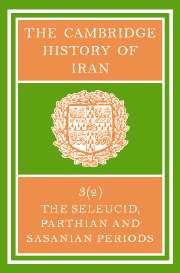Book contents
- Frontmatter
- PART 5 INSTITUTIONS
- PART 6 RELIGIOUS HISTORY
- 22 DEVELOPMENT OF RELIGIOUS THOUGHT
- 23 ZOROASTRIAN RELIGION
- 24 JEWS IN IRAN
- 25 CHRISTIANS IN IRAN
- 26 BUDDHISM AMONG IRANIAN PEOPLES
- 27(a) MANICHAEISM AND ITS IRANIAN BACKGROUND
- (b) MAZDAKISM
- PART 7 ART HISTORY
- PART 8 LANGUAGES AND LITERATURE
- PART 9 BIBLIOGRAPHY
- Bibliography
- Index
- Index of Greek words
- References
24 - JEWS IN IRAN
from PART 6 - RELIGIOUS HISTORY
Published online by Cambridge University Press: 28 March 2008
- Frontmatter
- PART 5 INSTITUTIONS
- PART 6 RELIGIOUS HISTORY
- 22 DEVELOPMENT OF RELIGIOUS THOUGHT
- 23 ZOROASTRIAN RELIGION
- 24 JEWS IN IRAN
- 25 CHRISTIANS IN IRAN
- 26 BUDDHISM AMONG IRANIAN PEOPLES
- 27(a) MANICHAEISM AND ITS IRANIAN BACKGROUND
- (b) MAZDAKISM
- PART 7 ART HISTORY
- PART 8 LANGUAGES AND LITERATURE
- PART 9 BIBLIOGRAPHY
- Bibliography
- Index
- Index of Greek words
- References
Summary
JEWISH SETTLEMENT IN THE WESTERN SATRAPIES OF IRAN
Jews settled in the Tigris-Euphrates river system long before the region fell under the rule of Iranian governments, and they remained long afterward. The first community consisted of the upper classes of northern Israel, exiled in 722 b.c. to Hālah, and on the Habor, the river of Gozan” (2 Kings 17.6, 18.11), the Khābūr river area, around Nisibis. Jewish settlement in the same territory is well attested in the 1st century a.d. and afterward, and it stands to reason that the later community derived from the earlier one, although the passage of six hundred years and the formation of legends about the “ten lost tribes of Israel” do little to illuminate what happened in between. The second, and far more important settlement, in central Babylonia along the rivers and the Royal Canal, followed the destruction of the first Temple, in 587 b.c. In addition to the two larger communities we know about smaller ones from Armenia to the Persian Gulf, north-eastward to the Caspian, eastward to Media, and, in later Sasanian times, in Fārs as well. But outside of central Babylonia, the Jews left no substantial records. In most instances our evidence about the location of Jews in various places is episodic and random. Jews did not constitute a majority in any one city, although in central Babylonia some villages were mainly, even exclusively, composed of Jews. In the mosaic of peoples and cultures in the western satrapies of Iran Jewry did not constitute a dominant or important element.
- Type
- Chapter
- Information
- The Cambridge History of IranSeleucid Parthian, pp. 909 - 923Publisher: Cambridge University PressPrint publication year: 1983
References
- 3
- Cited by



